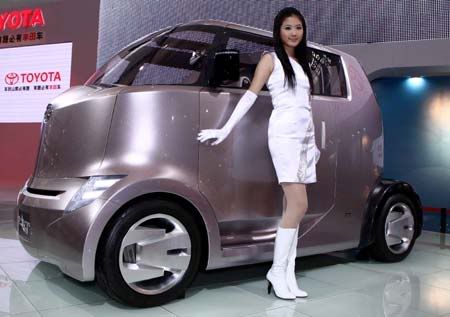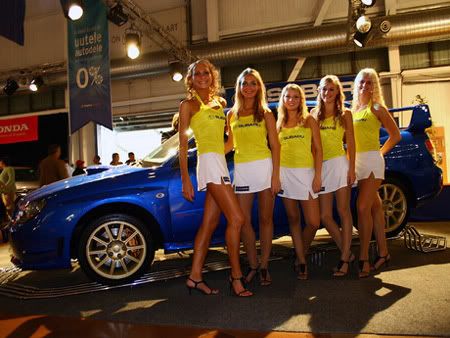How many car guys does it take to change a light bulb? Three normally, but only one if you've already lifted the engine block out of the way!
There's an actual reason for this joke which I'll explain in the epilogue. But let me shamelessly segue: there's a whole room full of car folks here in Nagoya, and they're working on something which needs a good more heavy lifting than needed to change that troublesome light bulb. They're building tomorrow's car systems. To help, QNX is hosting a full day event here in beautiful Nagoya, covering what the latest goings on are in the automotive space that's near and dear to our hearts--in-cab vehicle electronics.  |
| Getting seated before the day begins |
Our first presenter was Dr. Motoyuki Akamatsu, who broke the ice with a very entertaining video about an early 1966 study on driver distraction. The driver is wearing a device that looks like a giant eyelid that closes over his face on regular intervals, occluding his vision. The driver is coincidentally also the narrator, calmly describing the whole experiment as his view of the road is completely blocked every couple seconds or so. This is all while normal traffic is flowing around his car, totally unaware that this test driver could run into them at any moment. What they got away with in the sixties! The rest of his talk was equally informative; Akamatsu-san talked about how modern testing for driver distraction is done, and how mobiles can impact that.
I gave a talk about picking the right HMI (or UX if you prefer) framework for automotive infotainment. There's a ton of choice out there--HTML5, Adobe AIR, Qt, Android, Meego, EB Guide, OpenGL ES--I could go on and on. There are a lot of things to consider. Given that I didn't have an abundance of time and that it was all being dynamically translated into Japanese, I couldn't cover as much as I might have wanted. Look for a future blog from me where I can give the topic a little bit more space. (Mini-spoiler alert: I've listed my favorite first.)
The president of ARM Japan gave a talk about ARM use in vehicles. A short summary: ARM processors are on the rise everywhere in the car, and trending upwards. ARM licensed 6 billion CPUs last year, and they predict 100 billion devices by 2020. Japan is probably the only area where they aren't dominating (yet). A short roadmap then was presented about Cortex family--A8, A9, A15, and A5. Also he talked about the ARM M series. I must apologize that my jet lag affect my attention span during ARM M series (that architecture is almost irrelevant in infotainment, if that's an excuse). He also talked about ARM's Mali GPU built on Midgard architecture (supporting both OpenGLES 2.0 and DirectX9).
Alex Kinsella of RIM gave a talk about separation of personal and enterprise use of devices, in a way that gives simultaneously more freedom for the user and more options and security for the enterprise. All very cool stuff for enabling more OEM options to the vehicle.
Our very own Andrew Poliak talked about the various different connectivity options between cars and mobiles--both where we are today (MirrorLink, iPod Out, Remote Skin/BlueTooth SPP+A2DP) and where we see that they're going (HTML5, HDMI/MDL, USB 3.0).
 |
| Andrew explains OEM's evolving needs and timelines |
Roger Lanctot of Strategy Analytics had a lot of interesting things to share about their in-depth research, covering current industry trends and some of Roger's predictions.
- Global smartphones are right now 38% of the mobile market, with all signs of growth.
- You need good traffic info that's predictive. If it's not, its worthless, and navigation and traffic services are still the biggest customer desire out of an in-car system.
- Solve distraction problems before they are regulated out by governments.
- Apps in the car will be very important. Their research shows over 55% buyers (world wide average) want it. OEMs though take note--this will sell cars, but there's no profit in it for the OEM themselves.
- Many different connectivity options exist. Nobody has hmi nailed yet, so there's a big opportunity to get it right.
- HMI solutions are converging on mobile device communications.
 |
| Roger lists every mobile connectivity solution known to man |
Probably most emphasized facts of Roger's presentation were about China.
- China is important. If you don't play there you're writing your own ticket for irrelevance. It's the fastest growing automotive market, with a rich aftermarket space.
- China infotainment solutions are like the wild west right now, and include some crazy displays that Roger showed us with dozens of touch buttons. They've even got systems that have the ability to create and edit docs while driving! Microsoft Word at 70mph, here I come! I can't wait for the next IDE to have in-vehicle recognition so I can program while driving.
- China has exceedingly complex HMIs with apparent disregard for any regulations that might exist.
- China is not the safest place. They've got tons of new drivers, new infrastructure, and growth rates that exceed their experience. The World Health Organization estimates 200,000 vehicle fatalities (significantly higher than China's officially reported numbers). That's around 18% the world total vehicular fatalities. Wow.
Finally, our VP of Sales and Marketing Derek Kuhn ended up with a description of where QNX is going for the future automotive platforms with QNX CAR 2. In a word? Awesomeness. (Coincidentally, this is Derek's favourite word.) In ten? Full support for almost everything car makers ever dreamed of.
We wrapped up the day with a cocktail hour for all our guests and some Formula 1 race day ticket give-aways to some lucky attendees.
Guests having caught their taxis or trains, and the show nicely wrapped, the QNX staff gave secret surprise birthday wishes to our Alison Canavan, the world's best event coordinator, and to the world's most thoughtful person and our Auto Summit Japan emcee, Kosuke Abe.
All in all, a very busy and successful day. I'm pooped. And that's a wrap.
You've probably forgotten about the car guy lightbulb joke already, but I'll finish explaining it anyway. My girlfriend had one of her car's headlights burn out, and she asked me if I could fix it. My male chivalry and handyman pride made me jump at the opportunity to help! I naively went out to the car with a screwdriver, expecting to maybe loosen the screws around the light enclosure, pop out the bulb, put in the new one, and dust off my hands for a well deserved beer in one minute flat. It became immediately obvious that Honda had something much more nefarious in mind when they built the Civic. No screws. You had to remove the bulb from the back, but there wasn't any obvious way for a human hand (well, no adult human, anyway) to fit in the allotted space. I went back into the house, grabbed a handful of tools this time, and spent the next 20 minutes trying to figure out what parts of the car needed to be disassembled to get at the light bulb. This wasn't immediately fruitful either, so I went back in the house, consulted the Internet, and lo and behold--I wasn't just an idiot. I found many other posts from many other delighted Civic owners. It looked like the most popular solution was to remove the battery, battery cage and power steering pump mounts, lift the power steering out of the way, and then you could get at the bulb. More of a challenge than I was really looking for, I'm afraid, so I went back to my girlfriend, tail between my legs, and shamefully recommended that she take it to the dealer.
I couldn't help smiling at her retelling of the dealer visit. The first mechanic came out, all confident with a line something like "well, many guys don't really know how to do car stuff, so we'll take care of it." Then he spent about 15 minutes digging around, trying to discover how on earth you get the stupid bulb out. He finally had to call over his boss to get assistance. They did end up replacing the bulb, but it was a little more complicated than he expected too! Tally it up--me and two mechanics--three guys to replace a light bulb.
Good thing that building automotive software is so much easier.
 Speech interfaces have received a lot of attention recently, especially with the marketing blitz for Siri, the new speech interface for the iPhone.
Speech interfaces have received a lot of attention recently, especially with the marketing blitz for Siri, the new speech interface for the iPhone.



































































